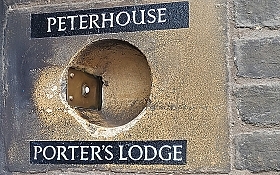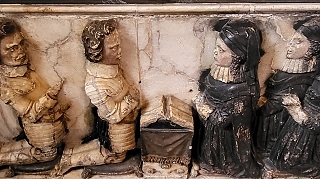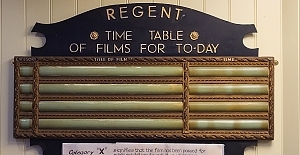Adam Yamey's Blog: YAMEY, page 108
November 6, 2022
Faces of India for Queen Victoria
THE CORRIDORS LEADING to the spectacular Durbar Room in Osborne House on the Isle of Wight are lined with portraits of people born in pre-independence India, either painted or photographed during the 19th century. Most of these images depict members of the Indian aristocracy (e.g., rulers of Princely States). A few depict less exalted persons, such as craftsmen and the designer of the Durbar Room.

Maharajah Duleep Singh (1838-1893), who surrendered the Koh-i-Noor diamond to Queen Victoria, is portrayed in a few pictures, notably one by the famous German artist Franz Xaver Winterhalter (1805-1873). Many other paintings were created by the Austrian painter Rudolf Swoboda (1859-1914). Queen Victoria liked his painting style and commissioned him to create more than 40 portraits of Indian people. In 1886, the queen paid for him to travel to India, and gave him £300 in travelling expenses. Her instructions to the young artist were:
“The Sketches Her Majesty wishes to have – are of the various types of the different nationalities. They should consist of heads of the same size as those already done for The Queen, and also small full lengths, as well as sketches of landscapes, buildings, and other scenes. Her Majesty does not want any large pictures done at first, but thinks that perhaps you could bring away material for making them should they eventually be wished for.” (www.rct.uk/collection/403755/gulzar).
Many of these can be seen hanging in Osborne House. Amongst his many Indian portraits, there is at least one painted not in India but in England. Queen Victoria had several servants, who were born in British India and the Princely States associated with it. The best known of these ‘imported’ servants was her favourite Mohammed Abdul Karim (1863-1909), her ‘munshi’ (teacher), who helped her study Hindustani, which she learned to write competently in the Urdu script. Amongst Swoboda’s paintings of Indians hanging in Osborne House, there is one of a non-Indian, a lady from Cyprus, and another, a Cape Malay woman from Cape Town (South Africa). Why they are there, I have not yet found out, but maybe Swoboda spotted them at the Colonial Exhibition held in London in 1886.
Not all the portraits of Indians are painted. Some of them are hand-coloured photographs. A few of these photos are signed by their creators, one of which was the photographic studio of Gobind Ram and Oodey Ram in Jaipur. Along with a studio in Calcutta the Ram brothers were pioneers in photography in 19th century India. One source (www.indiatoday.in/lifestyle/whats-hot...) stated:
“Apparently, studio photography was practised by many Maharajas as a means of leisure, mostly using their courtesans as subjects. The Ravi Varma Studios of Calcutta and Gobind Ram-Oodey Ram Studio in Jaipur are just two examples.”
As can be seen at Osborne, these photographers also made portraits of the maharajahs and their families.
Although Queen Victoria loved Osborne House, I cannot see its appeal apart from the wonderful Durbar Room. For me, seeing this lavishly decorated hall and the collection portraits of the Indian people are the main delights of this otherwise rather gloomy residence.
November 5, 2022
A cavity in a Cambridge College

DURING A RECENT visit to Cambridge, I noticed a hemispherical cavity into which an electric doorbell push button had been fitted. it was at Peterhouse College. I posted a picture of it on Facebook and received the following range of replies and reactions to it. Here they are in the order they appeared:
“My guess is there used to be a handle in there to operate a mechanical bell. There would have been a brass escutcheon plate, dished like the hole to accommodate the clenched hand grasping the handle. There seems to be a void behind the current bell button, the linkage probably went through there. You can see a shadow either side, rather like a bow tie, where the escutcheon was.”
“.. pull a cord or chain?”
“That will summon David Jason.”
“A square bell in a round hole”
“This was my husband’s college (about 45 years ago). I’m sure he’ll remember this well.”
“Yes, but I would expect the bar or chain operating the original to come straight out of the back of the cone, and there’s no hint of that.”
The range of comments was from frivolous to informative. I find that posting interesting items on Facebook often elicits useful information about them. By judicious posting and cross-checking information provided, Facebook can become a useful research tool.
November 4, 2022
Seen in the park

Black and white stripes
Adorn their long furry tails
Two lemurs in a cage
These two lemurs live in a cage in Golders Hill Park in northwest London. You can discover more about Golders Green and its wonderful park in my new book: https://www.amazon.co.uk/gp/product/B0BHG873FB/
November 3, 2022
DEFACED TO DEFY: an exciting exhibition in Cambridge
POLITICAL PROTEST AND CONFLICT can be expressed in a wide variety of ways. Defacement of commonplace items is one of these. It forms the basis of a temporary exhibition, “Defaced!”, being held at the Fitzwilliam Museum in Cambridge (Cambridgeshire) until the 8th of January 2023.

Many of the exhibits on display are banknotes that have been defaced or altered in design to express a political message or protest. One example of this is a five-dollar US banknote with the words “All Lives Can’t Matter until Black Lives Matter” embossed on its portrait of Abraham Lincoln. Another is a five hundred Indian rupee note with a coloured picture of an endangered rare bird printed over it. Yet another banknote is designed to look like a British £20 note at first sight, but it soon becomes apparent that it is not what it seems: it has been modified to include a portrait of ex-Prime Minister Boris Johnson and the words “The ruling class. We own you.” It also includes the words “We were born to lead, you were born to follow.” Other banknotes have been redesigned so that they appear to be valueless: e.g. zero Japanese Yen and zero US Dollars. The diversity of altered banknotes and parodies of actual banknotes on display is staggering.
Occasionally banknotes lose their value during periods of hyperinflation. The exhibition includes several examples of objects, such as wallets, made using trashed valueless notes. Particularly striking is a life-size sculpture of a hand grenade made using shredded PRC ten Yuan banknotes.
There are also many coins on show. They have all been altered to express protest and/or political sentiments. One dramatic example of this is a coin issued in France during the reign of Napoleon III. This was altered by carefully cutting around and removing the portrait of Napoleon III from the coin, leaving the rest of the coin intact. There are several coins and medals on display that depict political events such as the American Revolution and the Peterloo Massacre. A few coins relate to the unrest in Northern Ireland. One of them is a 1970 Republic of Ireland fifty pence coin with the words “Ulster is British” stamped on it.
The show at the Fitzwilliam does not confine itself to the defacement and parody of currency for political and protest purposes. It also includes currency either modified or specially created for special purposes. Simple examples of these are overprinting of low value notes during hyperinflation and modification of currency for use by the military or in POW camps. There are also coins, notes, and certificates created for specific purposes, for example for use in the Siege of Mafeking and for use by Boer prisoners imprisoned by the British in India.
Although most of the exhibits are related to currency (coins and notes), one room is dedicated to a spectacular sculptural exhibit, an installation called “Big Bang 2. Debt in transit”. A video is projected onto a wall. It shows a Ford Transit van being blown up by explosives. As it flies into pieces, bits of paper all marked with the word ‘debt’ float down like snowflakes. The film is projected in a room in which the fragments of the van are suspended from the ceiling so that the viewer appears to be seeing a still from the video but in three dimensions. The installation, which is a protest on the exorbitant interest on payday loans, makes a very powerful visual impact. (SEE my video of this posted on YouTube: https://youtu.be/7MgdDTfBivw)
November 2, 2022
An uninteresting artist in a Hertfordshire church
SAWBRIDGEWORTH IS AN ATTRACTIVE small town with many picturesque old buildings and a parish church, St Mary’s, whose construction began in the 13th century. It is an unusual edifice, being about as wide as its length, rather than longer than its width as is the case for most English churches. It contains a fine selection of elaborate funerary sculptures.

The most impressive funerary monument is the memorial to John Leventhorpe and his wife Joan, who died in 1625 and 1627 respectively. Within a multi-coloured marble frame, both of the deceased are depicted reclining on their left sides with their heads propped up by their left hands. John holds a sword in his right hand and Joan a small book in hers, Beneath the two statues, the couple’s six sons (one of whom, Arthur, died as a baby) and eight daughters are depicted in bas-relief, all kneeling in prayer. Baby Arthur is also present on the memorial but has been sculpted much smaller than his brothers. The whole sculptural ensemble is magnificent, and if you had time to see only one thing in Sawbridgeworth, this should not be missed.
High on the wall facing the Leventhorpe memorial, there is a smaller one, commemorating Jeremiah Milles (died 1797) and his wife Rose, who died in 1835. It is typical of early 19th century memorial art. It shows a female mourner in Hellenic dress kneeling in front of a sarcophagus. It was sculpted by John Termouth (1795-1849) of Pimlico (London).
The sculptor of the Leventhorpe memorial has been forgotten, but Termouth, who sculpted the Milles memorial, has not been consigned to obscurity. A notice in St Mary’s revealed that Termouth was:
“… an uninteresting artist whose symbolism was always obvious, hackneyed, and uninspired.”
November 1, 2022
Moved by the wind in Fowey
October 31, 2022
Bringing India to Queen Victoria in England
OSBORNE HOUSE ON the Isle of Wight was one of Queen Victoria’s favourite residences. Apart from one room within it, I was not overly impressed by the place. That room, which alone is a very good reason to visit Osborne, is the ornate Durbar Room. Entering this vast hall is like stepping inside an exuberantly decorated Maharajah’s palace somewhere in India. It is a superb example of the Indo-Saracenic style, which is according to one definition (on Wikipedia) was:
“… a revivalist architectural style mostly used by British architects in India in the later 19th century, especially in public and government buildings in the British Raj, and the palaces of rulers of the princely states. It drew stylistic and decorative elements from native Indo-Islamic architecture, especially Mughal architecture, which the British regarded as the classic Indian style, and, less often, from Hindu temple architecture.”

The Durbar Room was built not in India but in the country that ruled it at the time. It was designed not by a British architect but by a man from British India – Ram Singh (1858-1916), who was born in Rasulpur in the Punjab (now a village in Pakistan). His skills were recognised at a young age when he was seen working in a woodcarver’s shop in Amritsar. The man who spotted his talent was Rudyard Kipling’s father, the art teacher Lockwood Kipling (1837-1911). At the time, Lockwood was the first principal of the Mayo School of Industrial Arts, Lahore (established in 1875). He enrolled Ram as a student. Ram Singh was a successful student and soon became assistant drawing master at the school and Lockwood’s protégé. The two men collaborated in many important projects including designing Aitchison College in Lahore, the Mayo School in Lahore, and both the Indian Passage and ballroom at Bagshot Park (near Windsor). The work he had done in England led to him and Lockwood Kipling being given the commission to design the Durbar Room at Osborne.
The Durbar Room was designed to accommodate large ceremonial occasions and to reflect Queen Victoria’s exalted position as Empress of India, a role created by the British Parliament in 1876. This room, completed in 1891 as an extension of Osborne House, with its riotous array of mainly Mughal-style plasterwork decorations might have served yet another purpose. By the time it was completed, Victoria had never visited India, and at the age of over 70 years was unlikely to do so (and never did). In a way, the Durbar Room brought India to Victoria, and judging by its appearance, did so very well.
October 30, 2022
Regent: a cinema regenerated in a small town in Dorset
OVER THE YEARS, many cinemas that were opened in the first half of the 20th century have either been closed or converted to be used for other purposes. A substantial number of them were built in the Art Deco style, which flourished in the 1920s and ‘30s. Some cinemas, such as the Ionic and the ABC in Golders Green and the Odeon in Temple Fortune, have been demolished. Others became bingo halls or meeting places for religious groups. The Coronet in Notting Hill Gate began life as a theatre, then became a cinema, and is now a theatre again. During a recent visit to Christchurch in Dorset, I saw a cinema, designed in the Art Deco style, which is still in business.

The Regent Cinema stands on Christchurch’s High Street. It is in pristine condition – a fine example of Art Deco architecture and internal design – it looks as if it has been built recently. Opened on Boxing Day 1931, it continued showing films until it closed in July 1973. After that, like so many other cinemas, it was operated by the Mecca company as a bingo hall and social club. This functioned until it closed in 1982. Late that year, the building was purchased by Christchurch Borough Council.
The local authority together with over 100 volunteers restored the Regent to its original Art Deco glory. In June 1983, the Regent Centre with its cinema were opened for use. Since then, the restoration of the cinema has continued and technological improvements have been made (e.g., digital cinema has been introduced). Very recently (in 2021) further work has been done to recreate the original cinema (e.g., the cinema’s seats, carpet and colour schemes, have been restored to their original appearance, and 35 mm projection has returned). Given all this loving care the cinema has received, it is no wonder that it looks like new. Now, it is mainly run by keen volunteers. It is very heartening to discover a cinema that has survived closure and repurposing and lived to return to being used for the purpose it was originally designed. On the Sunday morning that we visited it, we were unable to enter the auditorium because it was filled with children enjoying the screening of a film. However, the ticket office contains a good set of photographs of the restored cinema’s interior.
October 29, 2022
Shelley died abroad and is remembered in Dorset
THE PRIORY CHURCH in Christchurch (Dorset) is all that remains intact of the Priory of the Holy Trinity, one of many monastic institutions dissolved by King Henry VIII. The king allowed the cathedral-like priory church to be preserved and used as Christchurch’s parish church. The rest of the priory was demolished. The church’s construction began in the Norman era, the nave being completed by about 1150. The church contains many fine Norman architectural and decorative features. On the north wall at the west end of the building, at the bottom of the square bell tower, there is a 19th century monument that commemorates one of England’s great poets and his equally famous wife, a novelist.

In 1816, the poet Percy Bysshe Shelley (1792-1822) married the novelist, author of “Frankenstein”, Mary Wollstonecraft Shelley (1797-1851). Six years later, Percy was in Italy, where he met Leigh Hunt and Lord Byron to discuss establishing a new journal to be called ‘The Liberal’. During this trip, Shelley died at sea (on the 1st of July 1822). His body was washed up near Viareggio ten day later. It was cremated on the beach. However, his heart resisted burning (possibly because it was highly calcified due to a tubercular infection). His ashes were buried in the Protestant Cemetery in Rome, and his heart was eventually buried either at St Peters Church in Bournemouth or at the Priory Church in Christchurch, Mary, Percy’s wife, died in her home in London’s Chester Square, but was buried at St Peter’s Church in Bournemouth, which was near her seaside home at Boscombe (now part of Bournemouth).
The monument to Percy and Mary in the Priory Church was sculpted in white marble by Henry Weekes (1807-1877) in 1853-54. It was erected by Percy and Mary’s son, who lived at Boscombe. The memorial:
“… shows Mary Wollstenecraft Shelley mourning over the body of her husband who drowned off the coast of Italy in 1822.” (https://victorianweb.org/sculpture/weekes/8.html).
After attending Sung Eucharist one Sunday morning in October (2022), we asked the cleric why the monument was in the Priory Church. He was not entirely sure of the reason, but suggested that at the time when the memorial was put up, Bournemouth was far smaller than its older neighbour Christchurch. He explained that before the arrival of the railway in 1870, Bournemouth was a smallish place, a village, and that Christchurch was a far larger and more important place, a town, in the area. Whatever the explanation, it was interesting to discover this monument to Shelley during our visit to the beautiful, venerable Priory Church.
October 28, 2022
Vanished from Ventnor
THERE WAS A TIME when one could take a train from London to Portsmouth, cross the Solent by ferry to Ryde on the Isle of Wight, and then take another train from Ryde to Ventnor. This was before 1966 when the station at Ventnor was closed forever. A century earlier, in 1866, this station opened to rail traffic. The closure was part of an extensive plan (devised by Dr Richard Beeching [1913-1985]) to reduce Britain’s railway mileage.

The station, the southern terminus of the isle of Wight Railway, with its associated sidings was located on the site of an old quarry. It was almost completely surrounded by high cliffs. Trains reached it from Shanklin by emerging from a 1312-yard-long tunnel running beneath St Boniface Down. It must have been dramatic emerging from the tunnel to find oneself in the space surrounded by vertiginous rocky walls.
Today, the entrance to the tunnel, through which water pipes now run, is hidden by dense foliage. Nothing remains of the tracks, and only a small part of the former station building (ticket office etc.) remains. The space once occupied by the platforms and railway lines is now occupied by an assortment of buildings, comprising an industrial estate. Trains still run between Ryde and Shanklin, but Ventnor station has all but vanished.




